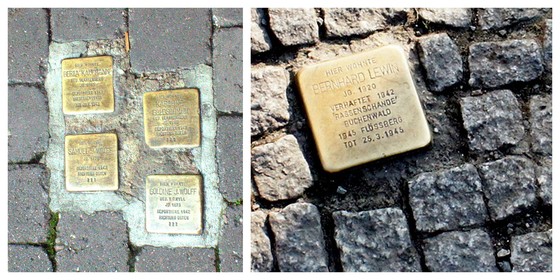Stolpersteine in Germany. Right, a single stone and its brass plaque attest to the presence in Berlin of one Bernard Lewin, arrested and deported in 1942. Left, a cluster of stones to mark the residence on the main square in Höxter of the Blankenberg sisters, both in their late 70s when they were deported to Theresienstadt in 1942, along with the Wolff family.
 An artist is not expected to be prolific, just inspired. We have this notion that creating art should require the investment of time, energy, soul-searching anguish. A single masterpiece that would represent a life's work. But Leonardo da Vinci and Pablo Picaso tossed off sketches, sculptures, and paintings with apparent ease. Mozart seemed to breathe music onto the page.
An artist is not expected to be prolific, just inspired. We have this notion that creating art should require the investment of time, energy, soul-searching anguish. A single masterpiece that would represent a life's work. But Leonardo da Vinci and Pablo Picaso tossed off sketches, sculptures, and paintings with apparent ease. Mozart seemed to breathe music onto the page.
Which leads to a good question: can one have both an artist's vision and a master craftsman's dedication? I think you could make a case for Günther Demnig, who has personally created (one by one, over the past decade) Europe's largest monument to the victims of the Holocaust: over 48,000 "memorial stones" in 18 countries, embedded in the sidewalk in front of the houses where they once lived. The stones, known as Stolpersteine, (literally: stumbling stones) honor victims of the Nazi extermination of Jews, Gypsies, homosexuals, and political enemies.
They are symbolic, of course; no one could possibly provide an adequate visualization of the immensity of the Holocaust. And they are not without controversy, A century ago; if you stubbed your toe walking down the street, you might have reflexively muttered an anti-Semitic oath. No more.
There are museums, yes, and monuments, even a cemetery-like park in Berlin, but they all seem to say "Look at me," while the Stolpersteine are underfoot, almost unseen; you don't notice them...until you do.
NB: Elizabeth Kolbert also wrote a piece in The New Yorker about Demnig and his Stolperstein memorials.

Leave a comment